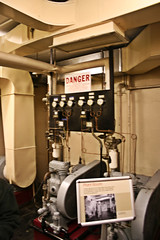But you probably knew all that. Here I'm going to share a few things that I found in Whitby during my last visit that I wasn't aware of before.

(Image (c) English Heritage, nabbed off their website)
Miniature shop of miniatures
There's a shop that sells miniature collectibles in less than mint condition for very cheap, right next to the market square. I always missed it before, partly because I was only recently into miniatures and partly because it's only big enough for three people to stand up in - and those three people have to like each other. The man who runs the shop is noticeably eccentric, and makes up the prices as he goes along. He rummages through boxes on shelves that stretch all the way up to the ceiling for adorable little cars and train carriages that are caked in dust and haphazardly tosses them onto a tiny little folding table saying, 'That's what, a quid I reckon?' I got a fairly major expansion to my train set for six pounds there, and I'm looking forward to patching up the beaten up items just as much as I'm looking forward to admiring the shinier ones.
Train and bus
Recently the North York Moors steam train line was expanded to reach Whitby. This is a lovely way to enjoy the moors, pass through Hogsmead station (actually Goathland station) and reminisce about a British golden age that is probably much nicer to fantasize about than to actually live through. I love steam trains and would recommend this to anybody, although it is expensive. However, the last train back to Pickering is fairly early, at 5 or 6 o'clock, and it's a shame to leave Whitby so early. The Abbey is open until 6, and the streets definitely look their best in twilight. Rather than catch the train back, we took the bus from Whitby to Pickering. It costs well under a fiver and if you sit on the top deck you get 360-degree panoramic views of the moors (which I have no earthly idea how to photograph well, so sorry for the lack of images). The bus route is much prettier than the train route. It goes all the way through Goathland village, which is used for the TV series Heartbeat, past a radar station that looks like it landed from outer space, and over some really wonderful valleys.
Whitby Abbey visitor centre
Whitby Abbey is run by English Heritage, so if you're a smug, self-satisfied English Heritage member like me then you get in for free. Seriously, EH membership is worth every penny. Obviously, the abbey ruins are pretty. All abbey ruins are pretty. But the visitor centre was a really pleasant surprise. It's in the ~ and includes an exhibition on two floors - the first floor shows some of the excavations from Whitby, which run from the dark ages to the 1940s. In a very intelligent way that is neither condescending nor overly specialised, the displays show you British cultural history through the prism of Whitby abbey. The ground floor is about historical study and research itself, with a short video presentation that, although goofily shot and clearly aimed at children, is genuinely insightful and well worth watching - postmodernism for kids is surprisingly compelling!


